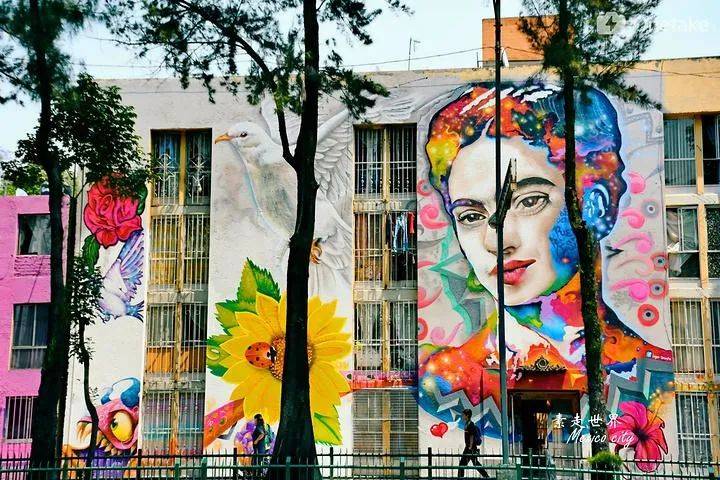Do you like murals? Meet Mexico’s “three masters of murals.
6 min read
Stepping into the city buildings of Mexico, you can see huge murals everywhere. In the turbulent times, Mexican artists put aside their personal preferences and dedicated themselves to creating public art for the masses. After the end of the Mexican nationalist revolution, they gradually became the protagonists in the cultural and social life of the country.
Since the 1920s, the Mexican mural movement, which aims at revitalizing and innovating national culture and art, takes mural painting as the main artistic means and paints local folk customs, landscapes, history and real life as the main objects, has emerged in Mexico. A large number of muralists, represented by the “three masters of frescoes” of Diego Rivera, Jose Clermont Orozco and David Alfaro Sigueros, emerged. They adapted the painting techniques learned from Europe to reflect the real life and struggles in Mexico and achieved brilliant achievements, producing a large number of masterpieces. It became a great revolutionary movement in the art history of Mexico and the world, and had an important influence on the painting art of Latin America, Europe and the United States.
Jose Clermont Orozco, the oldest of the “Three Frescoes”, was born in 1883 in Sarportan, Kanethsk. When he was young, he moved to Mexico City with his family and studied in agronomy school and national preparatory school. Influenced by Mexican printmaker Jorge Posada, he studied sketching at the College of SAN Carlos in 1908 and later became an architect. He lost his left hand at the age of 17 due to an explosion caused by a chemical experiment and has since become an artist. Orozco was exposed to a wide variety of artists and schools of art, and developed a keen interest in symbolism.
In 1916, he took part in a national exhibition organized by the government, and in September he held his first solo exhibition. But the results of the exhibition nearly destroyed his ideals, he said: “I had patiently propped up in the torrent of public insults against my ill-fated exhibition, but when I read the newspapers widely and found myself being insulted in such a way, I could no longer remain calm.”
Feeling hopeless, Orozco left for the United States the next year. In San Francisco he painted signs, and in New York he was so poor that he could only draw dolls’ faces for a small salary. Orozco returned to Mexico City in 1920, where he was still an unknown cartoonist. He drew satirical pictures for the major newspapers and magazines of the time and was known for his sharp style. It was not until July 1923, when Orozco accepted Vasconceros’ appointment to begin painting his first mural in the central patio of the National Preparatory School, that his brilliant artistic career began.
By this time, Sigelos had completed his first mural at the Academy. In 1927, he went to the United States again and produced a series of oil paintings reflecting the production of big machines. Prometheus, a large mural painted for Pomona College in California in 1930, marked a turning point in his art form. He returned to China in 1934 and painted decorative murals for Guadalajara City Hall. In 1939, he painted the mural “Burning Man” for the foundling Hospital of the city, showing the evolution of human beings in different periods throughout history.
In the late 1940s, he was commissioned to paint murals for many important buildings in Mexico. His main works include The Destruction of the Old Order, The Laborer, The Insurgents, Hidalgo and the Liberation, Juarez and the Reformation, etc. From 1943 to 1948, he held six mural studies and color sketches, which were well received by people. His works focus on national themes, some reflecting the Mexican Revolution, others exposing capitalism and social ills. Artistically, it inherits the advantages of European Baroque school, absorbs expressionism and modern printmaking techniques, and combines traditional symbolic techniques of ancient Mexican art to form its own unique mural style, which has a strong realistic expression. When Orozco died at the height of his creative powers in 1949, the Mexican Congress declared that his body would be placed in the Shrine of Great Men forever.
David Alfaro Sigeiros is the youngest member of the Mural Trio. Sigeiros was born in Mexico in 1896. Although his family was wealthy, his parents were absent from his childhood, and his grandfather and siblings became his most influential family members. Like Orozco, he studied at SAN Carlos College. By the time Sigelos arrived at the academy in 1911, new artistic ideas were attacking the old, stilted, collegiate way of teaching. Students are no longer willing to endure long sketching assignments and daily mechanical drawings of still lifes and ancient Greek plaster casts. By striking schools, they paved the way for the establishment of an advanced teaching system by destroying the old system that had suffered for generations.
At the age of 18, Sigelos and his friends from art school joined the revolutionary army to fight Mexico’s dictator. As he marched across the country, the son of a wealthy family experienced firsthand the plight of ordinary Mexicans struggling with poverty. The reality of what happened to Mexican civilians gave him a new perspective on the revolution. At the same time, the Mexican folk culture pervades daily life, giving Sigueros a constant source of inspiration for his work. Social reality, traditional national culture and art of the new era are intertwined and integrated in Sigeiros’ mind, and he seeks a brand new form of artistic creation — social realism belonging to Mexico.
In 1919, Sigeiros left Mexico with a scholarship awarded by the government. In his first stop in Paris, he first came into contact with French modern art and got acquainted with many famous French artists, among which Leger had the greatest influence on him. In addition, under the influence of Rivera, Sigelos developed a keen interest in Cezanne’s works.
In 1920, he left Paris to study Italian Renaissance painting and Baroque painting. Of all the paintings he saw, Masaccio’s impressed him the most, and Sigelos went to Florence specifically to study his frescoes. He was also impressed by Baroque art, which created the perspective techniques that would later appear in the frescoes of Sigueros.
After returning to Mexico, Sigelos, Rivera, Orozco and others organized by the new government launched public art education in the form of murals, trying to establish a new and modern Mexican art culture. They painted large murals on famous buildings in Mexico — this became known in art history as the Mexican Mural Movement. In addition to the frescoes, Sigeiros created a series of lithographs. The works were exhibited across the United States, bringing Mexican art back into the public eye after Rivera and provoking intense debate. In the fervent atmosphere, Sigelos founded an art school, hoping to train more talented and independent-minded young artists. Among them was Jackson Pollock.
Diego Rivera is the most well-known of the three murals. In February 2019, I wrote about Rivera on my official account. Labeled a child prodigy early in his life, Rivera enrolled in the Accademia de SAN Carlos at the age of 10 and was already a well-known artist in Mexico when, at the age of 36, he began work on his first fresco at the Polliva Opera House in 1922. He is a true philanderer. His legendary love affair with Frida, a Mexican painter, is also widely known. He is also the most prolific and controversial figure among the “three Mural masters”.
In 1921, Rivera returned to Mexico to work on a public mural project commissioned by Vasconceros and began painting his first mural. Together with Orozco and Sigeiros, he launched the mural movement to promote the Mexican democratic revolution in the form of mural paintings. The works take the life and struggles of the people as the theme, which is a new style combining the traditional Mexican national and modern techniques.
He created murals with a total area of nearly 30,000 square meters during his lifetime. Among them are Genesis, Fertile Soil, Mexican History and Future, People at the Crossroads, Sunday Afternoon Dream, The Nightmare of war and the Ideal of Peace, The Night of the Rich, and the Night of the Poor. In 2002, the Hollywood film “Frida”, a biopic directed by Julie Taymor and starring Mexican actress Salma Hayek, chronicled the legendary career of Frida and Rivera.






